Overview modeling approches part 1
Download as pptx, pdf0 likes910 views
This document provides an overview of sequential accident modeling approaches. It discusses domino, fault tree, and events and causal factors charting models. These sequential models describe accidents as a linear sequence of events. While useful for identifying direct causes, they do not account for latent factors or variability in sociotechnical systems. The document also reviews academic literature on accident modeling and comparisons of investigation methods.
1 of 25
Downloaded 51 times
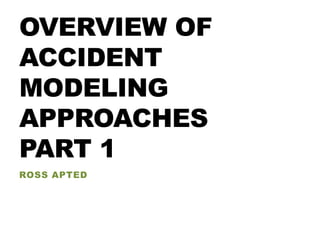

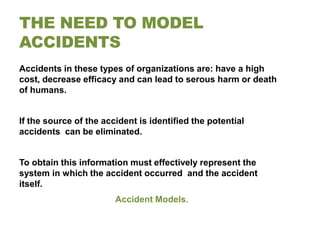
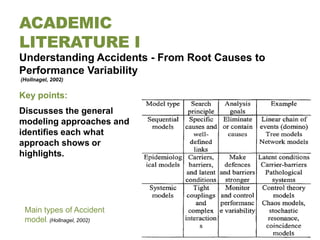
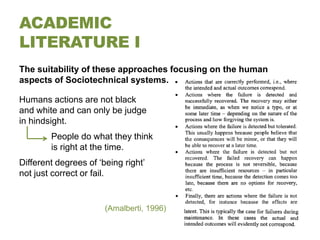

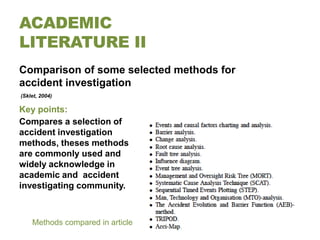
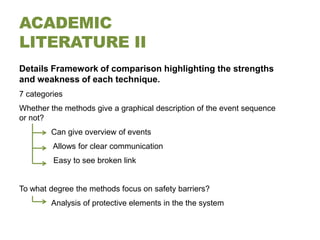

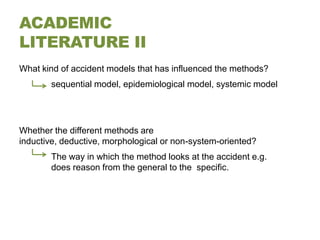


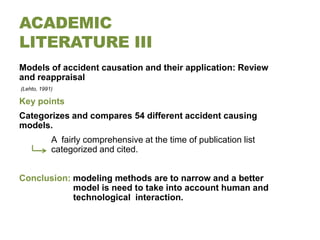

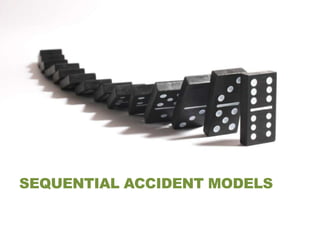

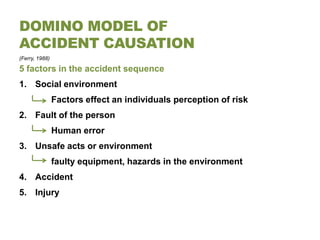
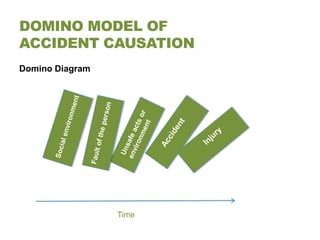
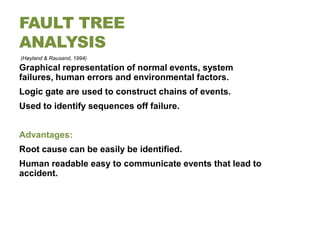
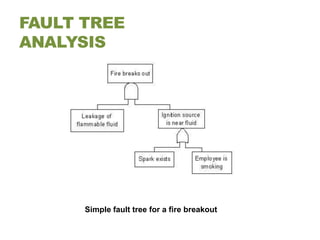
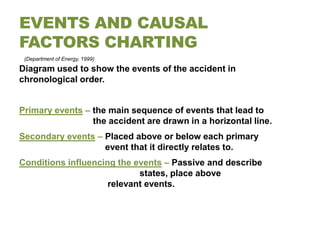
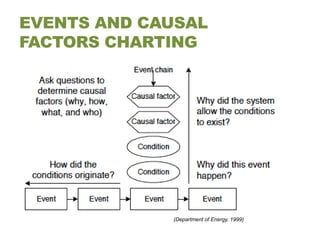



Ad
Recommended
Summary of Selected Accident Modeling Papers
Summary of Selected Accident Modeling Papers stargate1280
Ėý
This document summarizes and compares several accident modeling approaches described in journal articles and conference proceedings. It discusses sequential, epidemiological, and systemic modeling approaches. Specific models summarized include the domino model, Swiss cheese model, and Normal Accidents theory. The role of humans in accidents is also examined. The document concludes that no single approach is best, and multiple methods should be used together to analyze accidents in complex systems.Overview of Systemic Modeling Approaches
Overview of Systemic Modeling Approachesstargate1280
Ėý
This document provides an overview of four systemic accident modeling techniques: CREAM, FRAM, AcciMap, and STAMP. It discusses the background, key ideas, and methods for each technique. It also expands upon a framework for comparing accident modeling techniques, analyzing the techniques on factors like accident sequence consideration, safety barrier focus, analytical levels and approaches, and training needs.Summary of Selected Accident Modeling Papers
Summary of Selected Accident Modeling Papers stargate1280
Ėý
This document summarizes and compares two journal articles on accident modeling approaches. The first article by Hollnagel describes general modeling approaches like sequential, epidemiological, and systemic models. It also discusses the role of humans in accidents in terms of their actions and work mentality. The second article by Sklet compares 14 accident investigation methods based on criteria like graphical representation, safety barriers focus, and required expertise. Both articles highlight the importance of using multiple modeling approaches and accounting for human factors when investigating accidents.01677377
01677377Zineddine ALICHE
Ėý
The document presents an Aviation System Risk Model (ASRM) developed by NASA and the FAA to assess risks from low probability, high consequence aviation accidents. The ASRM uses Bayesian belief networks to model causal factors and their probabilistic relationships leading to different types of accidents. It was developed through analyzing accident case studies and expert knowledge elicitation. The model identifies precursors from accident reports and inserts new technologies to evaluate their potential risk mitigation effectiveness.Accident Causation
Accident CausationNAJEEMDEEN ILIYAS
Ėý
This document discusses accident causation and workplace safety. It outlines several accident causation models from simple linear models to complex non-linear models. It also discusses factors that can lead to workplace accidents like lack of training or unsafe conditions. The document notes that accident investigations are important to identify causes and implement corrective actions to reduce risks. Finally, it discusses employees' rights to compensation and benefits for workplace injuries under relevant laws and regulations.Accident Analysis Models And Methods Guidance For Safety Professionals
Accident Analysis Models And Methods Guidance For Safety ProfessionalsLeslie Schulte
Ėý
This document provides an overview of accident analysis models and methods. It discusses three categories of analysis techniques: sequential, epidemiological, and systemic. Sequential techniques view accidents as resulting from time-ordered causal events, but cannot adequately account for organizational and human factors. Epidemiological techniques were developed to consider organizational influences, and view accidents as stemming from latent failures within a system. More recently, systemic techniques have emerged that treat socio-technical systems holistically and focus on the interactions between system components. The document aims to inform readers on different analysis approaches and factors that influence model selection.Accident Model for investigation and preventive action
Accident Model for investigation and preventive actionAnnisaMaulidya15
Ėý
The document discusses various models and classifications of accidents, emphasizing the importance of understanding past accidents for prevention and control strategies. It categorizes accidents based on frequency and severity and explores methods for accident investigation, causation, and prediction. Various models, including Rasmussen's and Hadden's frameworks, are detailed for analyzing and preventing accidents in both technical and sociotechnical systems.CS5032 Lecture 10: Learning from failure 2
CS5032 Lecture 10: Learning from failure 2John Rooksby
Ėý
The document discusses investigations into accidents and failures. It explains that investigations aim to identify underlying causes rather than just immediate causes. The basic steps of an investigation include collecting evidence, analyzing facts, making judgements about causes and responsibilities, and making recommendations. Complex events require narrative approaches, causal chains, or systems approaches to analysis. While investigations provide lessons, predicting all problems is difficult given the complex nature of systems.FTA.pptx
FTA.pptxBigbearBigbear
Ėý
The document provides an agenda and overview for a two-day workshop on reliability and system risk analysis techniques. Day one focuses on classical qualitative techniques including Failure Modes and Effects Analysis (FMEA), Fault Tree Analysis, Event Tree Analysis, and HAZOP. Day two will cover systems-theoretic techniques and human factors. The workshop introduces concepts of reliability, risk, failure, and safety and discusses how accidents can result from both component failures and unsafe interactions. Traditional techniques like FMEA have limitations and may not capture issues related to design, requirements, or organizational factors.Hsse safety iceberg theory gp
Hsse safety iceberg theory gpNoor Ezlina
Ėý
1. The document discusses several accident theories including the Domino Theory, Energy Theory, and Multiple Factor Theories. It also outlines different approaches to hazard avoidance such as enforcement, psychological, engineering, and analytical.
2. Key accident causes mentioned include unsafe acts, unsafe conditions, human factors like overload and inappropriate responses. Accident costs can be direct such as medical expenses or indirect like lost productivity.
3. Successful hazard avoidance requires considering factors like management, the individual, equipment, and their interactions, with an emphasis on engineering controls and an analytical approach supported by top management.CHAPTER15 Leaming from Accidents While no company want.docx
CHAPTER15 Leaming from Accidents While no company want.docxmccormicknadine86
Ėý
The document discusses the importance of learning from accidents in organizations, emphasizing that they present opportunities to improve safety programs and prevent future incidents. Effective communication and a structured accident review process are critical for disseminating lessons learned and ensuring that corrective actions are taken. Additionally, the document highlights the need for a proactive safety approach that identifies and addresses systemic issues before accidents occur.CHAPTER15 Leaming from Accidents While no company want.docx
CHAPTER15 Leaming from Accidents While no company want.docxspoonerneddy
Ėý
The document discusses the importance of learning from workplace accidents to improve safety programs and prevent recurrence. It emphasizes that communication, thorough accident investigations, and a systematic approach to analyze and address underlying causes are critical for enhancing safety. It also highlights the need for a proactive stance in safety measures and the implementation of corrective actions to protect personnel and maintain a company's reputation.H7-SafetyHFE.pdf
H7-SafetyHFE.pdfsofiamuhammad2
Ėý
This document discusses human factors engineering and safety. It defines an accident, provides accident statistics from the UK, and discusses conceptual models of the accident process including the chain of multiple events model, epidemiological model, energy exchange model, behavioral models, and systems safety model. It also covers human error classification schemes, categories of human errors including mistakes and slips, and speed-accuracy tradeoffs in human performance.Root cause analysis
Root cause analysisKailash Chaudhary
Ėý
The document provides an overview of incident investigation and root cause analysis. It discusses conducting an investigation by securing the incident scene, interviewing witnesses, developing a sequence of events, and performing different levels of analysis including injury analysis, surface cause analysis, and root cause analysis to identify the underlying causes. Root cause analysis seeks to identify weaknesses in the safety management system that contributed to the incident. Effective recommendations should propose both immediate corrective actions and long-term system improvements to policies, programs, and procedures.5.-accident-causation-theories-accident-reporting.pptx
5.-accident-causation-theories-accident-reporting.pptxssuser1ecccc
Ėý
This document discusses accident causation theories and accident reporting. It describes several theories of accident causation including Heinrich's accident sequence theory, multiple causation theory, and biased liability theory. It also discusses accident costs, common myths, and the importance of identifying and analyzing contributing factors through root cause analysis. The document emphasizes the importance of accurate, timely accident reporting and how electronic reporting systems can help organizations collect, track, and analyze accident data.Asse bragatto 24_feb_10
Asse bragatto 24_feb_10Bragattop
Ėý
1. The document discusses knowledge management in mature industries where accidents still occur due to existing knowledge being ignored, forgotten, or misapplied, rather than a lack of knowledge.
2. It proposes using near-miss events to "wake up" dormant knowledge by walking through a company's internal safety management system or browsing external regulatory documents and technical literature.
3. Specifically, it presents software called NOCE that links near-misses to a company's digital safety documents and equipment models to surface relevant sleeping knowledge, and an ontology for tagging and searching unstructured external safety information sources.Human Error Prevention
Human Error PreventionToru Nakata
Ėý
The document discusses theories and preventive measures regarding human error, emphasizing the unpredictable nature of mistakes even among skilled individuals. It provides case studies illustrating significant human errors in various contexts, such as medical mishaps and industrial accidents. Additionally, it outlines strategies and tools to enhance human abilities and prevent errors, including fool-proof systems, check methodologies, and promoting an awareness of tasks.Overview of Systemic Modeling Approaches
Overview of Systemic Modeling Approachesstargate1280
Ėý
This document provides an overview of four systemic accident modeling techniques: CREAM, FRAM, AcciMap, and STAMP. It discusses the background, key ideas, and methods for each technique. It also expands upon a framework for comparing accident modeling techniques, analyzing the techniques on factors like accident sequence consideration, safety barrier focus, analytical levels and approaches, and training needs.Analytical frameworks Lecture of Traffic Safety.pptx
Analytical frameworks Lecture of Traffic Safety.pptxEngradnanSalam1
Ėý
The document discusses analytical frameworks for identifying risk factors in road traffic injuries (RTIs), focusing on the public health approach, the Haddon matrix, and the systems approach. It outlines steps to analyze risk factors and develop interventions to reduce accidents and trauma severity, emphasizing the importance of understanding the complexity of road systems and the interactions among various elements. By the end of the course, students will be equipped to apply these frameworks to analyze RTIs relevant to their regions.Superstrings of Safety
Superstrings of Safetyaskegg
Ėý
The document discusses the complexities of health and safety management, comparing large-scale (quantitative) and small-scale (qualitative) perspectives. It advocates for a unified model that accounts for various factors such as energy and its role in accidents, suggesting significant changes in key performance indicators to effect cultural shifts in safety. Emphasizing the need for a new system, it calls for measuring the right elements to ensure effective management and real results in safety outcomes.Running head ACCIDENT INVESTIGATION1ACCIDENT INVESTIGATION5.docx
Running head ACCIDENT INVESTIGATION1ACCIDENT INVESTIGATION5.docxSUBHI7
Ėý
The document analyzes the safety failures leading to a propane explosion at Little General Store, which resulted in multiple fatalities and injuries. It highlights critical errors in safety inspections, compliance with regulations, and procedural adherence by Ferrellgas, the propane supplier. The investigation confirms that better adherence to safety protocols could have prevented the incident, and the need for further analysis was deemed unnecessary as the findings were satisfactory.Igene - PhD SICSA Poster Presentation
Igene - PhD SICSA Poster PresentationNetzone Resources Nig. Ltd.
Ėý
The document compares four accident analysis models - Events and Causal Factors (ECF), Human Factors Analysis and Classification System (HFACS), System-Theoretic Accident Model and Processes (STAMP), and Rasmussen's AcciMaps - in their analysis of a medication dosing error case study involving a computerized physician order entry (CPOE) system. It finds that while the models identify common causes, such as human-computer interaction issues, AcciMaps and STAMP provide the deepest analysis by examining contributing factors across multiple levels of the sociotechnical system, but that the reliability of AcciMap analysis needs improvement for healthcare applications.Research methods for socio-technical systems analysis (LSCITS EngD 2012)
Research methods for socio-technical systems analysis (LSCITS EngD 2012)Ian Sommerville
Ėý
This document discusses research methods for studying socio-technical systems, with a focus on case studies and fieldwork. It describes case studies as an in-depth retrospective analysis of a single case using multiple data sources. Fieldwork involves directly observing work in real-world settings rather than relying on reports. Techniques discussed include ethnography, interviews, and concurrent or evaluative fieldwork combined with iterative development. The key is to understand human factors specific to a system by talking to users and observing work as it is performed.InvestigAction: a cognitive and organisational tool for learning from acciden...
InvestigAction: a cognitive and organisational tool for learning from acciden...ALIAS Network
Ėý
The document outlines the development and implementation of a customized accident investigation protocol aimed at improving safety in the oil and gas industry. It emphasizes a shift from a blame culture to a learning opportunity approach, combining organizational and cognitive views to enhance organizational resilience and prevent adverse events. Additionally, it discusses the collaboration of all stakeholders and the training of investigators to promote a culture of active safety and continuous improvement.Normalization of Deviance
Normalization of Deviance mmcharter
Ėý
1) The document discusses the history and evolution of error management in complex systems over the past century from a focus on individual factors to increasingly wider systemic and organizational factors.
2) Key events and investigations like Tenerife, Challenger, and Columbia shifted focus to organizational culture and policies in addition to technical issues.
3) However, the document notes concerns that the focus on remote and systemic factors may have swung too far away from individual responsibility and that revisiting individual factors could again benefit prevention efforts.Fault tree analysis
Fault tree analysiselsonpaul11
Ėý
This document provides an overview of fault tree analysis including:
- Fault tree analysis models possible failure combinations using logic gates like AND and OR to relate events leading to an undesired top event.
- It involves defining the system, top event, tree structure, then exploring each branch in detail until all failure pathways are identified.
- Boolean algebra is used to evaluate the tree qualitatively by finding minimal cut sets, and quantitatively by calculating failure probabilities.
- An example fault tree is provided for a simple electric motor circuit to demonstrate the construction process and rules.Incident investigation and reporting
Incident investigation and reportingJillian Bower
Ėý
To prevent future incidents, thoroughly analyze investigation data by examining metrics to identify trends over several years. Look for either a series of identical incidents pointing to issues with safety controls, or a broader pattern indicating problems with human factors that require long-term solutions like training. Communicate the investigation findings and any corrective actions to management and employees to provide the biggest benefit of preventing similar incidents.Incident investigation and reporting
Incident investigation and reportingJillian Bower
Ėý
To prevent future incidents, thoroughly analyze investigation data by examining metrics to identify trends over several years. Look for either a series of identical incidents pointing to issues with safety controls, or a broader pattern indicating problems with human factors that also need addressing through training. Communicate the investigation findings and any corrective actions to management and employees to provide the biggest benefit of preventing similar incidents.Final
Finalstargate1280
Ėý
The document summarizes Ross Apted's 2012 internship where he researched and modeled complex system accidents. He spent 3 weeks researching failures of systems like space shuttles and flash trading crashes. For 4 weeks he researched accident modeling approaches like sequential, epidemiological, and systemic models. For the final 5 weeks, he used these approaches to model the 1989 British Midlands Flight 92 crash caused when the crew shut down the wrong engine in an emergency.Fault Tree - Kegworth
Fault Tree - Kegworthstargate1280
Ėý
This fault tree analysis examines the causes of the Kegworth air disaster in which British Midland Flight BD 92 crashed on landing at East Midlands Airport in 1990. The primary cause was the pilots shutting down the wrong engine (the right engine) due to judgment error likely caused by insufficient protocols for dealing with simultaneous symptoms of vibration and smoke from the engines. Contributing factors included equipment failure, poor aircraft design with no way for pilots to visually confirm the engine status, inadequate training so pilots didn't know about differences in the air conditioning system, and potential flaws in engine design allowing metal fatigue and heavy vibrations.More Related Content
Similar to Overview modeling approches part 1 (20)
FTA.pptx
FTA.pptxBigbearBigbear
Ėý
The document provides an agenda and overview for a two-day workshop on reliability and system risk analysis techniques. Day one focuses on classical qualitative techniques including Failure Modes and Effects Analysis (FMEA), Fault Tree Analysis, Event Tree Analysis, and HAZOP. Day two will cover systems-theoretic techniques and human factors. The workshop introduces concepts of reliability, risk, failure, and safety and discusses how accidents can result from both component failures and unsafe interactions. Traditional techniques like FMEA have limitations and may not capture issues related to design, requirements, or organizational factors.Hsse safety iceberg theory gp
Hsse safety iceberg theory gpNoor Ezlina
Ėý
1. The document discusses several accident theories including the Domino Theory, Energy Theory, and Multiple Factor Theories. It also outlines different approaches to hazard avoidance such as enforcement, psychological, engineering, and analytical.
2. Key accident causes mentioned include unsafe acts, unsafe conditions, human factors like overload and inappropriate responses. Accident costs can be direct such as medical expenses or indirect like lost productivity.
3. Successful hazard avoidance requires considering factors like management, the individual, equipment, and their interactions, with an emphasis on engineering controls and an analytical approach supported by top management.CHAPTER15 Leaming from Accidents While no company want.docx
CHAPTER15 Leaming from Accidents While no company want.docxmccormicknadine86
Ėý
The document discusses the importance of learning from accidents in organizations, emphasizing that they present opportunities to improve safety programs and prevent future incidents. Effective communication and a structured accident review process are critical for disseminating lessons learned and ensuring that corrective actions are taken. Additionally, the document highlights the need for a proactive safety approach that identifies and addresses systemic issues before accidents occur.CHAPTER15 Leaming from Accidents While no company want.docx
CHAPTER15 Leaming from Accidents While no company want.docxspoonerneddy
Ėý
The document discusses the importance of learning from workplace accidents to improve safety programs and prevent recurrence. It emphasizes that communication, thorough accident investigations, and a systematic approach to analyze and address underlying causes are critical for enhancing safety. It also highlights the need for a proactive stance in safety measures and the implementation of corrective actions to protect personnel and maintain a company's reputation.H7-SafetyHFE.pdf
H7-SafetyHFE.pdfsofiamuhammad2
Ėý
This document discusses human factors engineering and safety. It defines an accident, provides accident statistics from the UK, and discusses conceptual models of the accident process including the chain of multiple events model, epidemiological model, energy exchange model, behavioral models, and systems safety model. It also covers human error classification schemes, categories of human errors including mistakes and slips, and speed-accuracy tradeoffs in human performance.Root cause analysis
Root cause analysisKailash Chaudhary
Ėý
The document provides an overview of incident investigation and root cause analysis. It discusses conducting an investigation by securing the incident scene, interviewing witnesses, developing a sequence of events, and performing different levels of analysis including injury analysis, surface cause analysis, and root cause analysis to identify the underlying causes. Root cause analysis seeks to identify weaknesses in the safety management system that contributed to the incident. Effective recommendations should propose both immediate corrective actions and long-term system improvements to policies, programs, and procedures.5.-accident-causation-theories-accident-reporting.pptx
5.-accident-causation-theories-accident-reporting.pptxssuser1ecccc
Ėý
This document discusses accident causation theories and accident reporting. It describes several theories of accident causation including Heinrich's accident sequence theory, multiple causation theory, and biased liability theory. It also discusses accident costs, common myths, and the importance of identifying and analyzing contributing factors through root cause analysis. The document emphasizes the importance of accurate, timely accident reporting and how electronic reporting systems can help organizations collect, track, and analyze accident data.Asse bragatto 24_feb_10
Asse bragatto 24_feb_10Bragattop
Ėý
1. The document discusses knowledge management in mature industries where accidents still occur due to existing knowledge being ignored, forgotten, or misapplied, rather than a lack of knowledge.
2. It proposes using near-miss events to "wake up" dormant knowledge by walking through a company's internal safety management system or browsing external regulatory documents and technical literature.
3. Specifically, it presents software called NOCE that links near-misses to a company's digital safety documents and equipment models to surface relevant sleeping knowledge, and an ontology for tagging and searching unstructured external safety information sources.Human Error Prevention
Human Error PreventionToru Nakata
Ėý
The document discusses theories and preventive measures regarding human error, emphasizing the unpredictable nature of mistakes even among skilled individuals. It provides case studies illustrating significant human errors in various contexts, such as medical mishaps and industrial accidents. Additionally, it outlines strategies and tools to enhance human abilities and prevent errors, including fool-proof systems, check methodologies, and promoting an awareness of tasks.Overview of Systemic Modeling Approaches
Overview of Systemic Modeling Approachesstargate1280
Ėý
This document provides an overview of four systemic accident modeling techniques: CREAM, FRAM, AcciMap, and STAMP. It discusses the background, key ideas, and methods for each technique. It also expands upon a framework for comparing accident modeling techniques, analyzing the techniques on factors like accident sequence consideration, safety barrier focus, analytical levels and approaches, and training needs.Analytical frameworks Lecture of Traffic Safety.pptx
Analytical frameworks Lecture of Traffic Safety.pptxEngradnanSalam1
Ėý
The document discusses analytical frameworks for identifying risk factors in road traffic injuries (RTIs), focusing on the public health approach, the Haddon matrix, and the systems approach. It outlines steps to analyze risk factors and develop interventions to reduce accidents and trauma severity, emphasizing the importance of understanding the complexity of road systems and the interactions among various elements. By the end of the course, students will be equipped to apply these frameworks to analyze RTIs relevant to their regions.Superstrings of Safety
Superstrings of Safetyaskegg
Ėý
The document discusses the complexities of health and safety management, comparing large-scale (quantitative) and small-scale (qualitative) perspectives. It advocates for a unified model that accounts for various factors such as energy and its role in accidents, suggesting significant changes in key performance indicators to effect cultural shifts in safety. Emphasizing the need for a new system, it calls for measuring the right elements to ensure effective management and real results in safety outcomes.Running head ACCIDENT INVESTIGATION1ACCIDENT INVESTIGATION5.docx
Running head ACCIDENT INVESTIGATION1ACCIDENT INVESTIGATION5.docxSUBHI7
Ėý
The document analyzes the safety failures leading to a propane explosion at Little General Store, which resulted in multiple fatalities and injuries. It highlights critical errors in safety inspections, compliance with regulations, and procedural adherence by Ferrellgas, the propane supplier. The investigation confirms that better adherence to safety protocols could have prevented the incident, and the need for further analysis was deemed unnecessary as the findings were satisfactory.Igene - PhD SICSA Poster Presentation
Igene - PhD SICSA Poster PresentationNetzone Resources Nig. Ltd.
Ėý
The document compares four accident analysis models - Events and Causal Factors (ECF), Human Factors Analysis and Classification System (HFACS), System-Theoretic Accident Model and Processes (STAMP), and Rasmussen's AcciMaps - in their analysis of a medication dosing error case study involving a computerized physician order entry (CPOE) system. It finds that while the models identify common causes, such as human-computer interaction issues, AcciMaps and STAMP provide the deepest analysis by examining contributing factors across multiple levels of the sociotechnical system, but that the reliability of AcciMap analysis needs improvement for healthcare applications.Research methods for socio-technical systems analysis (LSCITS EngD 2012)
Research methods for socio-technical systems analysis (LSCITS EngD 2012)Ian Sommerville
Ėý
This document discusses research methods for studying socio-technical systems, with a focus on case studies and fieldwork. It describes case studies as an in-depth retrospective analysis of a single case using multiple data sources. Fieldwork involves directly observing work in real-world settings rather than relying on reports. Techniques discussed include ethnography, interviews, and concurrent or evaluative fieldwork combined with iterative development. The key is to understand human factors specific to a system by talking to users and observing work as it is performed.InvestigAction: a cognitive and organisational tool for learning from acciden...
InvestigAction: a cognitive and organisational tool for learning from acciden...ALIAS Network
Ėý
The document outlines the development and implementation of a customized accident investigation protocol aimed at improving safety in the oil and gas industry. It emphasizes a shift from a blame culture to a learning opportunity approach, combining organizational and cognitive views to enhance organizational resilience and prevent adverse events. Additionally, it discusses the collaboration of all stakeholders and the training of investigators to promote a culture of active safety and continuous improvement.Normalization of Deviance
Normalization of Deviance mmcharter
Ėý
1) The document discusses the history and evolution of error management in complex systems over the past century from a focus on individual factors to increasingly wider systemic and organizational factors.
2) Key events and investigations like Tenerife, Challenger, and Columbia shifted focus to organizational culture and policies in addition to technical issues.
3) However, the document notes concerns that the focus on remote and systemic factors may have swung too far away from individual responsibility and that revisiting individual factors could again benefit prevention efforts.Fault tree analysis
Fault tree analysiselsonpaul11
Ėý
This document provides an overview of fault tree analysis including:
- Fault tree analysis models possible failure combinations using logic gates like AND and OR to relate events leading to an undesired top event.
- It involves defining the system, top event, tree structure, then exploring each branch in detail until all failure pathways are identified.
- Boolean algebra is used to evaluate the tree qualitatively by finding minimal cut sets, and quantitatively by calculating failure probabilities.
- An example fault tree is provided for a simple electric motor circuit to demonstrate the construction process and rules.Incident investigation and reporting
Incident investigation and reportingJillian Bower
Ėý
To prevent future incidents, thoroughly analyze investigation data by examining metrics to identify trends over several years. Look for either a series of identical incidents pointing to issues with safety controls, or a broader pattern indicating problems with human factors that require long-term solutions like training. Communicate the investigation findings and any corrective actions to management and employees to provide the biggest benefit of preventing similar incidents.Incident investigation and reporting
Incident investigation and reportingJillian Bower
Ėý
To prevent future incidents, thoroughly analyze investigation data by examining metrics to identify trends over several years. Look for either a series of identical incidents pointing to issues with safety controls, or a broader pattern indicating problems with human factors that also need addressing through training. Communicate the investigation findings and any corrective actions to management and employees to provide the biggest benefit of preventing similar incidents.More from stargate1280 (7)
Final
Finalstargate1280
Ėý
The document summarizes Ross Apted's 2012 internship where he researched and modeled complex system accidents. He spent 3 weeks researching failures of systems like space shuttles and flash trading crashes. For 4 weeks he researched accident modeling approaches like sequential, epidemiological, and systemic models. For the final 5 weeks, he used these approaches to model the 1989 British Midlands Flight 92 crash caused when the crew shut down the wrong engine in an emergency.Fault Tree - Kegworth
Fault Tree - Kegworthstargate1280
Ėý
This fault tree analysis examines the causes of the Kegworth air disaster in which British Midland Flight BD 92 crashed on landing at East Midlands Airport in 1990. The primary cause was the pilots shutting down the wrong engine (the right engine) due to judgment error likely caused by insufficient protocols for dealing with simultaneous symptoms of vibration and smoke from the engines. Contributing factors included equipment failure, poor aircraft design with no way for pilots to visually confirm the engine status, inadequate training so pilots didn't know about differences in the air conditioning system, and potential flaws in engine design allowing metal fatigue and heavy vibrations.FRAM Analysis - Kegworth
FRAM Analysis - Kegworthstargate1280
Ėý
The document analyzes the Kegworth air disaster using FRAM (Functional Resonance Analysis Method). It describes the FRAM method which involves identifying essential functions, characterizing variability and dependencies, and proposing ways to monitor and control variability. It then applies FRAM to model the functions involved in the incident, characterizing each by aspects like time, input/output, preconditions, and control. This identifies how variability or lack of communication between functions like dealing with engine issues, smoke procedures and landing contributed to the accident.Cream analysis of the Kegworth Air Disaster
Cream analysis of the Kegworth Air Disasterstargate1280
Ėý
On January 8, 1989, British Midland Flight 92 crashed while attempting an emergency landing near Kegworth, England. An investigation found that a fan blade broke off in one of the engines, causing damage and a fire. The crew shut down the wrong engine and diverted to land, but the remaining engine failed during descent. The Cognitive Reliability and Error Analysis Method (CREAM) was developed to analyze accidents from both retrospective and prospective views by considering the context in which errors occurred. When applied to the Kegworth disaster, CREAM identified lack of aircraft knowledge, inadequate training, design flaws, and high workload as contributing factors in the crew's errors.Aviation accidents and incidents
Aviation accidents and incidentsstargate1280
Ėý
1) On January 8, 1989, British Midland Flight 92 crashed near Kegworth, England while attempting an emergency landing. An investigation found the flight crew shut down the wrong engine in response to a technical failure in the left engine.
2) On October 7, 2008, Qantas Flight 72 experienced uncommanded pitch downs due to incorrect data from an Air Data Inertial Reference Unit. The accident highlighted issues with relying solely on computer systems without adequate redundancy or human oversight.
3) A June 2012 AAIB bulletin reported a serious incident involving a Boeing 757 that lost power to its left electrical bus and instruments. The incident was traced to a corroded crimp terminal and demonstrated the AAColumbia and Challenger
Columbia and Challengerstargate1280
Ėý
This document summarizes investigations into two space shuttle disasters - the Columbia disaster of 2003 and the Challenger disaster of 1986. For both accidents, the initial investigations focused only on technical causes but later independent investigations took a broader view, examining organizational and human factors. The Columbia Accident Investigation Board determined that organizational issues within NASA, like budget cuts and scheduling pressures, contributed to NASA's failure to address known risks from foam shedding. The Rogers Commission also identified organizational failures, finding that NASA managers disregarded engineering concerns about low temperatures affecting the O-rings. Both accidents highlight the importance of considering multiple causal factors beyond just technical issues.2010 Flash Crash
2010 Flash Crashstargate1280
Ėý
The 2010 Flash Crash saw the Dow Jones Industrial Average fall over 600 points before quickly recovering. The crash was caused by a combination of factors including increased market volatility due to the Greek debt crisis, a large sell algorithm that flooded the market, and high-frequency traders exacerbating price movements by buying and selling among themselves. The crash highlighted issues with market structure and liquidity. Subsequent studies analyzed order flow toxicity and the role of liquidity in flash crashes. New regulations like circuit breakers were implemented to prevent future crashes.Ad
Recently uploaded (20)
MuleSoft for AgentForce : Topic Center and API Catalog
MuleSoft for AgentForce : Topic Center and API Catalogshyamraj55
Ėý
This presentation dives into how MuleSoft empowers AgentForce with organized API discovery and streamlined integration using Topic Center and the API Catalog. Learn how these tools help structure APIs around business needs, improve reusability, and simplify collaboration across teams. Ideal for developers, architects, and business stakeholders looking to build a connected and scalable API ecosystem within AgentForce.Using the SQLExecutor for Data Quality Management: aka One man's love for the...
Using the SQLExecutor for Data Quality Management: aka One man's love for the...Safe Software
Ėý
The SQLExecutor is one of FMEâs most powerful and flexible transformers. Pivvot maintains a robust internal metadata hierarchy used to support ingestion and curation of thousands of external data sources that must be managed for quality before entering our platform. By using the SQLExecutor, Pivvot can efficiently detect problems and perform analysis before data is extracted from our staging environment, removing the need for rollbacks or cycles waisted on a failed job. This presentation will walk through three distinct examples of how Pivvot uses the SQLExecutor to engage its metadata hierarchy and integrate with its Data Quality Management workflows efficiently and within the source postgres database. Spatial Validation âValidating spatial prerequisites before entering a production environment. Reference Data Validation - Dynamically validate domain-ed columns across any table and multiple columns per table. Practical De-duplication - Removing identical or near-identical well point locations from two distinct source datasets in the same table.Tech-ASan: Two-stage check for Address Sanitizer - Yixuan Cao.pdf
Tech-ASan: Two-stage check for Address Sanitizer - Yixuan Cao.pdfcaoyixuan2019
Ėý
A presentation at Internetware 2025." How to survive with 1 billion vectors and not sell a kidney: our low-cost c...
" How to survive with 1 billion vectors and not sell a kidney: our low-cost c...Fwdays
Ėý
Let's talk about our history. How we started the project with a small vector database of less than 2 million records. Later, we received a request for +100 million records, then another +100... And so gradually we reached almost 1 billion. Standard tools were quickly running out of steam - we were running into performance, index size, and very limited resources. After a long series of trials and errors, we built our own low-cost cluster, which today stably processes thousands of queries to more than 1B vectors.Mastering AI Workflows with FME by Mark DoĖring
Mastering AI Workflows with FME by Mark DoĖringSafe Software
Ėý
Harness the full potential of AI with FME: From creating high-quality training data to optimizing models and utilizing results, FME supports every step of your AI workflow. Seamlessly integrate a wide range of models, including those for data enhancement, forecasting, image and object recognition, and large language models. Customize AI models to meet your exact needs with FMEâs powerful tools for training, optimization, and seamless integrationTechniques for Automatic Device Identification and Network Assignment.pdf
Techniques for Automatic Device Identification and Network Assignment.pdfPriyanka Aash
Ėý
Techniques for Automatic Device Identification and Network AssignmentCapCut Pro Crack For PC Latest Version {Fully Unlocked} 2025
CapCut Pro Crack For PC Latest Version {Fully Unlocked} 2025pcprocore
Ėý
ððĄðžððē:ððžð―ð ðđðķðŧðļ & ð―ðŪðððē ðķðŧððž ððžðžðīðđðē ðŧðēð ððŪðŊ> https://pcprocore.com/ ðâ
CapCut Pro Crack is a powerful tool that has taken the digital world by storm, offering users a fully unlocked experience that unleashes their creativity. With its user-friendly interface and advanced features, itâs no wonder why aspiring videographers are turning to this software for their projects.OpenPOWER Foundation & Open-Source Core Innovations
OpenPOWER Foundation & Open-Source Core InnovationsIBM
Ėý
penPOWER offers a fully open, royalty-free CPU architecture for custom chip design.
It enables both lightweight FPGA cores (like Microwatt) and high-performance processors (like POWER10).
Developers have full access to source code, specs, and tools for end-to-end chip creation.
It supports AI, HPC, cloud, and embedded workloads with proven performance.
Backed by a global community, it fosters innovation, education, and collaboration.Cracking the Code - Unveiling Synergies Between Open Source Security and AI.pdf
Cracking the Code - Unveiling Synergies Between Open Source Security and AI.pdfPriyanka Aash
Ėý
Cracking the Code - Unveiling Synergies Between Open Source Security and AIThe Future of Technology: 2025-2125 by Saikat Basu.pdf
The Future of Technology: 2025-2125 by Saikat Basu.pdfSaikat Basu
Ėý
A peek into the next 100 years of technology. From Generative AI to Global AI networks to Martian Colonisation to Interstellar exploration to Industrial Nanotechnology to Artificial Consciousness, this is a journey you don't want to miss. Which ones excite you the most? Which ones are you apprehensive about? Feel free to comment! Let the conversation begin!Oh, the Possibilities - Balancing Innovation and Risk with Generative AI.pdf
Oh, the Possibilities - Balancing Innovation and Risk with Generative AI.pdfPriyanka Aash
Ėý
Oh, the Possibilities - Balancing Innovation and Risk with Generative AI2025_06_18 - OpenMetadata Community Meeting.pdf
2025_06_18 - OpenMetadata Community Meeting.pdfOpenMetadata
Ėý
The community meetup was held Wednesday June 18, 2025 @ 9:00 AM PST.
Catch the next OpenMetadata Community Meetup @ https://www.meetup.com/openmetadata-meetup-group/
In this month's OpenMetadata Community Meetup, "Enforcing Quality & SLAs with OpenMetadata Data Contracts," we covered data contracts, why they matter, and how to implement them in OpenMetadata to increase the quality of your data assets!
Agenda Highlights:
ð Introducing Data Contracts: An agreement between data producers and consumers
ð Data Contracts key components: Understanding a contract and its purpose
ð§âðĻ Writing your first contract: How to create your own contracts in OpenMetadata
ðĶū An OpenMetadata MCP Server update!
â And More!Quantum AI: Where Impossible Becomes Probable
Quantum AI: Where Impossible Becomes ProbableSaikat Basu
Ėý
Imagine combining the "brains" of Artificial Intelligence (AI) with the "super muscles" of Quantum Computing. That's Quantum AI!
It's a new field that uses the mind-bending rules of quantum physics to make AI even more powerful.Curietech AI in action - Accelerate MuleSoft development
Curietech AI in action - Accelerate MuleSoft developmentshyamraj55
Ėý
CurieTech AI in Action â Accelerate MuleSoft Development
Overview:
This presentation demonstrates how CurieTech AIâs purpose-built agents empower MuleSoft developers to create integration workflows faster, more accurately, and with less manual effort
linkedin.com
+12
curietech.ai
+12
meetups.mulesoft.com
+12
.
Key Highlights:
Dedicated AI agents for every stage: Coding, Testing (MUnit), Documentation, Code Review, and Migration
curietech.ai
+7
curietech.ai
+7
medium.com
+7
DataWeave automation: Generate mappings from tables or samplesâ95%+ complete within minutes
linkedin.com
+7
curietech.ai
+7
medium.com
+7
Integration flow generation: Auto-create Mule flows based on specificationsâspeeds up boilerplate development
curietech.ai
+1
medium.com
+1
Efficient code reviews: Gain intelligent feedback on flows, patterns, and error handling
youtube.com
+8
curietech.ai
+8
curietech.ai
+8
Test & documentation automation: Auto-generate MUnit test cases, sample data, and detailed docs from code
curietech.ai
+5
curietech.ai
+5
medium.com
+5
Why Now?
Achieve 10Ã productivity gains, slashing development time from hours to minutes
curietech.ai
+3
curietech.ai
+3
medium.com
+3
Maintain high accuracy with code quality matching or exceeding manual efforts
curietech.ai
+2
curietech.ai
+2
curietech.ai
+2
Ideal for developers, architects, and teams wanting to scale MuleSoft projects with AI efficiency
Conclusion:
CurieTech AI transforms MuleSoft development into an AI-accelerated workflowâletting you focus on innovation, not repetition.AI vs Human Writing: Can You Tell the Difference?
AI vs Human Writing: Can You Tell the Difference?Shashi Sathyanarayana, Ph.D
Ėý
This slide illustrates a side-by-side comparison between human-written, AI-written, and ambiguous content. It highlights subtle cues that help readers assess authenticity, raising essential questions about the future of communication, trust, and thought leadership in the age of generative AI."Scaling in space and time with Temporal", Andriy Lupa.pdf
"Scaling in space and time with Temporal", Andriy Lupa.pdfFwdays
Ėý
Design patterns like Event Sourcing and Event Streaming have long become standards for building real-time analytics systems. However, when the system load becomes nonlinear with fast and often unpredictable spikes, it's crucial to respond quickly in order not to lose real-time operating itself.
In this talk, Iâll share my experience implementing and using a tool like Temporal.io. We'll explore the evolution of our system for maintaining real-time report generation and discuss how we use Temporal both for short-lived pipelines and long-running background tasks.Security Tips for Enterprise Azure Solutions
Security Tips for Enterprise Azure SolutionsMichele Leroux Bustamante
Ėý
Delivering solutions to Azure may involve a variety of architecture patterns involving your applications, APIs data and associated Azure resources that comprise the solution. This session will use reference architectures to illustrate the security considerations to protect your Azure resources and data, how to achieve Zero Trust, and why it matters. Topics covered will include specific security recommendations for types Azure resources and related network security practices. The goal is to give you a breadth of understanding as to typical security requirements to meet compliance and security controls in an enterprise solution.Ad
Overview modeling approches part 1
- 2. SOCIO-TECHNICAL SYSTEMS Socio-technical system â The interactions between people and their behavior with technology while occupying society's complex infrastructures. Examples: Power plants, national healthcare system, space missions, stock market , aviation systems. What happens when they go wrong
- 3. THE NEED TO MODEL ACCIDENTS Accidents in these types of organizations are: have a high cost, decrease efficacy and can lead to serous harm or death of humans. If the source of the accident is identified the potential accidents can be eliminated. To obtain this information must effectively represent the system in which the accident occurred and the accident itself. Accident Models.
- 4. ACADEMIC LITERATURE I Understanding Accidents - From Root Causes to Performance Variability (Hollnagel, 2002) Key points: Discusses the general modeling approaches and identifies each what approach shows or highlights. Main types of Accident model. (Hollnagel, 2002)
- 5. ACADEMIC LITERATURE I The suitability of these approaches focusing on the human aspects of Sociotechnical systems. Humans actions are not black and white and can only be judge in hindsight. People do what they think is right at the time. Different degrees of âbeing rightâ not just correct or fail. (Amalberti, 1996)
- 6. ACADEMIC LITERATURE I In the sequential model an element is either correct or has failed, but human actions are not like this Human actions are better suited to the epidemiological model as it allows for latent conditions , it takes into account that action may contribute to accident over time. The systemic model is built on the concept of variability and does not focus on failures. This is perfect for representing variability of human action.
- 7. ACADEMIC LITERATURE II Comparison of some selected methods for accident investigation (Sklet, 2004) Key points: Compares a selection of accident investigation methods, theses methods are commonly used and widely acknowledge in academic and accident investigating community. Methods compared in article
- 8. ACADEMIC LITERATURE II Details Framework of comparison highlighting the strengths and weakness of each technique. 7 categories Whether the methods give a graphical description of the event sequence or not? Can give overview of events Allows for clear communication Easy to see broken link To what degree the methods focus on safety barriers? Analysis of protective elements in the the system
- 9. ACADEMIC LITERATURE II The level of scope of the analysis. Which levels of Rasmussenâs classification of sociotechnical systems (Rasmussen, 1997) does the method model. (Rasmussen, 1997)
- 10. ACADEMIC LITERATURE II What kind of accident models that has influenced the methods? sequential model, epidemiological model, systemic model Whether the different methods are inductive, deductive, morphological or non-system-oriented? The way in which the method looks at the accident e.g. does reason from the general to the specific.
- 11. ACADEMIC LITERATURE II Whether the different methods are primary or secondary methods? Primary Method â Self contained, stand alone method. Secondary Method â used in conjunction with other method to provide special input. The need for education and training in order to use the methods. Novice â no experience or training is needed. Specialist â In between Novice and expert. Expert â Formal education and training is needed.
- 12. ACADEMIC LITERATURE II Each method is briefly detailed, the comparison is analyzed and discussed. Characteristics of different methods. (Sklet, 2004) Conclusion: no one accident investigation technique is perfect and that to be most effective they must be used in conjunction.
- 13. ACADEMIC LITERATURE III Models of accident causation and their application: Review and reappraisal (Lehto, 1991) Key points Categorizes and compares 54 different accident causing models. A fairly comprehensive at the time of publication list categorized and cited. Conclusion: modeling methods are to narrow and a better model is need to take into account human and technological interaction.
- 16. SEQUENTIAL ACCIDENT MODELS Simplest form of accident modeling. Describes the accident as a series of events that occur in a particular order. Events occur along a linear timeline. Analysis: Identifies specific cause and broken links in accident chain. Goal is to eliminate broken links.
- 17. DOMINO MODEL OF ACCIDENT CAUSATION (Ferry, 1988) 5 factors in the accident sequence 1. Social environment Factors effect an individuals perception of risk 2. Fault of the person Human error 3. Unsafe acts or environment faulty equipment, hazards in the environment 4. Accident 5. Injury
- 18. DOMINO MODEL OF ACCIDENT CAUSATION Domino Diagram Time
- 19. FAULT TREE ANALYSIS (HÃļyland & Rausand, 1994) Graphical representation of normal events, system failures, human errors and environmental factors. Logic gate are used to construct chains of events. Used to identify sequences off failure. Advantages: Root cause can be easily be identified. Human readable easy to communicate events that lead to accident.
- 20. FAULT TREE ANALYSIS Simple fault tree for a fire breakout
- 21. EVENTS AND CAUSAL FACTORS CHARTING (Department of Energy, 1999) Diagram used to show the events of the accident in chronological order. Primary events â the main sequence of events that lead to the accident are drawn in a horizontal line. Secondary events â Placed above or below each primary event that it directly relates to. Conditions influencing the events â Passive and describe states, place above relevant events.
- 22. EVENTS AND CAUSAL FACTORS CHARTING (Department of Energy, 1999)
- 23. SEQUENTIAL ACCIDENT MODELS SUMMARY Advantages: Human readable, easy to communicate chain of events. Can identify root cause or break in chain of events that lead to accident. Good starting of point. Disadvantages: Does not take into account latent factors. Inadequate to model the variability of Sociotechnical systems.
- 24. SEQUENTIAL ACCIDENT MODELS SUMMARY More modeling techniques: âĒ Event tree analysis. âĒ Management and Oversight Risk Tree (MORT). âĒ Sequential Timed Events Plotting (STEP). âĒ Man, Technology and Organization (MTO)-analysis. âĒ TRIPOD Links last accessed 29/06/12
- 25. REFERENCES Amalberti, R. (1996). La conduite des systkmes ri risques. Paris: PUF. Department of Energy. (1999). DOE Workbook, Conducting Accident Investigations . Washington,: Department of Energy. Ferry, T. (1988). Modern Accident Investigation and Analysis. Second Edition. New York: Wiley. HÃļyland, A., & Rausand, M. (1994). System reliability Theory: Models and Statistical Methods. New York: Wiley. Hollnagel, E. (2002). Understanding accidents-from root causes to performance variability. Human Factors and Power Plants, 2002. Proceedings of the 2002 IEEE 7th Conference on , (pp. 1 - 1-6 ). Lehto, M. (1991). Models of accident causation and their application: Review and reappraisal. journal of engineering and technology management , 173. Rasmussen, J. (1997). Risk management in a dynamic society: a modelling problem. Safety Sci. , 183â213. Sklet, S. (2004). Comparison of some selected methods for accident investigation. Journal of hazardous materials , 29-37.